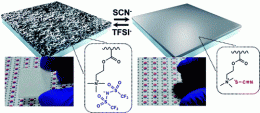New 'smart window' system with unprecedented performance

A new "smart" window system has the unprecedented ability to inexpensively change from summer to winter modes, darkening to save air conditioning costs on scorching days and returning to crystal clarity in the winter to capture free heat from the sun, scientists are reporting. Their study appears in the journal ACS Nano.
Ho Sun Lim, Jeong Ho Cho, Jooyong Kim and Chang Hwan Lee point out that the drive for energy conservation has fostered efforts to develop new types of window glass for everything from skylights and windows in houses to conference room walls in offices. "Smart" windows that reflect sunlight away from buildings in summer and switch back to full transparency in winter already are available. But they have many drawbacks, including high cost, rapid deterioration in performance, and manufacturing processes that involve potentially toxic substances. So, the researchers set out to develop a smart window that overcomes these drawbacks.
They discovered that using a polymer, so-called "counterions" and a solvent such as methanol was an inexpensive and less harsh way to make a stable, robust smart window. It has the added advantage of being extremely tunable — quickly and easily switching from 100% opaque to almost completely clear in seconds. "To our knowledge, such extreme optical switching behavior is unprecedented among established smart windows," the authors state. "This type of light control system may provide a new option for saving on heating, cooling and lighting costs through managing the light transmitted into the interior of a house."
More information: Counterion-Induced Reversibly Switchable Transparency in Smart Windows, ACS Nano, Article ASAP. DOI: 10.1021/nn202328y
Abstract
Smart windows that can reversibly alternate between extreme optical characteristics via clicking counteranions of different hydration energies were developed on glass substrates through the facile spray-casting of poly[2-(methacryloyloxy)ethyltrimethylammonium chloride-co-3-(trimethoxysilyl)propyl methacrylate]. The optical transmittance was either 90.9% or 0% over the whole spectral range when alternately immersed in solutions containing thiocyanate (SCN–) or bis(trifluoromethane)sulfonimide (TFSI–) ions, respectively. The extreme optical transitions were attributed to formation of microporous structures via the molecular aggregation of polyelectrolyte chains bearing TFSI– ions in methanol. Because the smart windows were either highly transparent toward or completely blocking of incident light upon direct counterion exchange, this kind of nanotechnology may provide a new platform for efficiently conserving on energy usage in the interior of buildings.
Provided by American Chemical Society


















